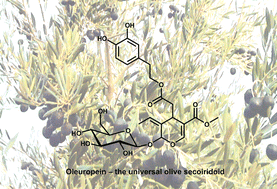Biosynthesis and biotransformations of phenol-conjugated oleosidic secoiridoids from Olea europaea L.
Abstract
Covering: primarily 1990 to 2007
The genus Olea contains the economically important European olive tree (Olea europaea L.). This species is also of chemotaxonomic interest because of the presence of various


 Please wait while we load your content...
Please wait while we load your content...